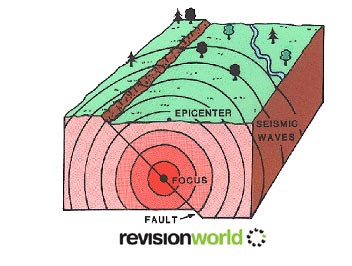An earthquake is the shaking and vibration of the crust due to plate tectonics (movement of plates).
Earthquakes can happen along any type of plate boundary. They also occur along faults which are large cracks in the earth’s crust. Most faults are associated with large plate boundaries where violent earthquakes usually occur.
Causes of Earthquakes
- Earthquakes are caused when the tension is released from inside the crust.
- This happens because plates do not move smoothly - sometimes they get stuck.
- When this happens a great deal of pressure builds up.
- Eventually this pressure is released and an earthquake tends to occur.

An earthquake starts deep below the earth’s surface at the focus. The focus is the point inside the Earth's crust where the pressure is released.
The epicentre of an earthquake is the position on the earth’s surface directly above its focus.
The jerking movement caused by plates sticking then moving releases built-up pressure inside the Earth's crust, in the form of seismic waves. The waves spread out from the focus.
The strongest waves are found near the centre of the earthquake. This means that the most severe damage caused by an earthquake will happen close to the epicentre.
It is almost impossible to predict when they will occur. The effect of an earthquake depends on the depth of an earthquake as well as its magnitude.
If the focus is very deep or the shockwaves have to travel through dense rock, the effect will be less
Effects of Earthquakes
Primary effects
- Occur immediately
- All due to the shaking of the ground e.g. buildings collapsing, destruction of roads and bridges.
Secondary effects
- Happen afterwards, but can be even more devastating e.g. fire, tidal waves, disease and landslides
The following video shows how a Tsunamis works, which are often caused by Earthquakes.
Case Study: Northwest Turkey, Izmit 1999
Primary effects:
- Over 20,000 deaths
- More than 100,000 buildings were destroyed
- Over 100,000 families homeless.
- Transport links destroyed
- Landslides
Secondary effects:
- Disease e.g. Cholera and typhoid (caused from polluted water)
- Services damaged e.g. water, electricity and sewage
- Intense heat and dust (people who were made homeless had no shelter, thus were exposed)
Measuring Earthquakes
Richter Scale
- The power (magnitude) of an earthquake is measured on the Richter scale, using an instrument called a seismometer.
- The Richter scale is numbered 0-10 with 10 being the most powerful.
- The Richter scale is logarithmic – an earthquake measuring 7 is 10 times more powerful than one measuring 6 and 100 times more powerful than one measuring 5.
Mercalli Scale
- The Mercalli scale measures the damage caused by an earthquake.
- The Mercalli scale goes from I to XII
